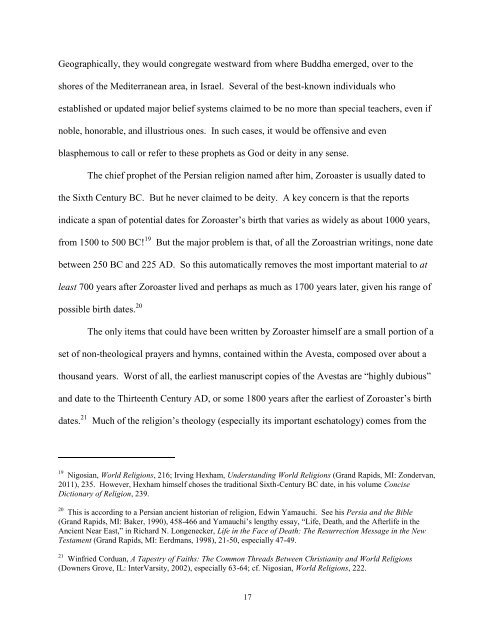Published by
299z7CN
299z7CN
Create successful ePaper yourself
Turn your PDF publications into a flip-book with our unique Google optimized e-Paper software.
Geographically, they would congregate westward from where Buddha emerged, over to the<br />
shores of the Mediterranean area, in Israel. Several of the best-known individuals who<br />
established or updated major belief systems claimed to be no more than special teachers, even if<br />
noble, honorable, and illustrious ones. In such cases, it would be offensive and even<br />
blasphemous to call or refer to these prophets as God or deity in any sense.<br />
The chief prophet of the Persian religion named after him, Zoroaster is usually dated to<br />
the Sixth Century BC. But he never claimed to be deity. A key concern is that the reports<br />
indicate a span of potential dates for Zoroaster’s birth that varies as widely as about 1000 years,<br />
from 1500 to 500 BC! 19<br />
But the major problem is that, of all the Zoroastrian writings, none date<br />
between 250 BC and 225 AD. So this automatically removes the most important material to at<br />
least 700 years after Zoroaster lived and perhaps as much as 1700 years later, given his range of<br />
possible birth dates. 20<br />
The only items that could have been written <strong>by</strong> Zoroaster himself are a small portion of a<br />
set of non-theological prayers and hymns, contained within the Avesta, composed over about a<br />
thousand years. Worst of all, the earliest manuscript copies of the Avestas are “highly dubious”<br />
and date to the Thirteenth Century AD, or some 1800 years after the earliest of Zoroaster’s birth<br />
dates. 21<br />
Much of the religion’s theology (especially its important eschatology) comes from the<br />
19 Nigosian, World Religions, 216; Irving Hexham, Understanding World Religions (Grand Rapids, MI: Zondervan,<br />
2011), 235. However, Hexham himself choses the traditional Sixth-Century BC date, in his volume Concise<br />
Dictionary of Religion, 239.<br />
20 This is according to a Persian ancient historian of religion, Edwin Yamauchi. See his Persia and the Bible<br />
(Grand Rapids, MI: Baker, 1990), 458-466 and Yamauchi’s lengthy essay, “Life, Death, and the Afterlife in the<br />
Ancient Near East,” in Richard N. Longenecker, Life in the Face of Death: The Resurrection Message in the New<br />
Testament (Grand Rapids, MI: Eerdmans, 1998), 21-50, especially 47-49.<br />
21 Winfried Corduan, A Tapestry of Faiths: The Common Threads Between Christianity and World Religions<br />
(Downers Grove, IL: InterVarsity, 2002), especially 63-64; cf. Nigosian, World Religions, 222.<br />
17


